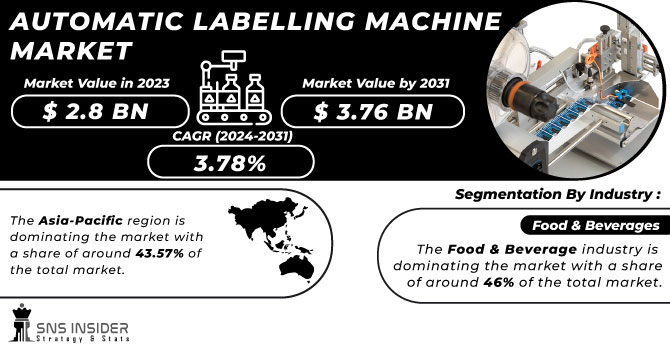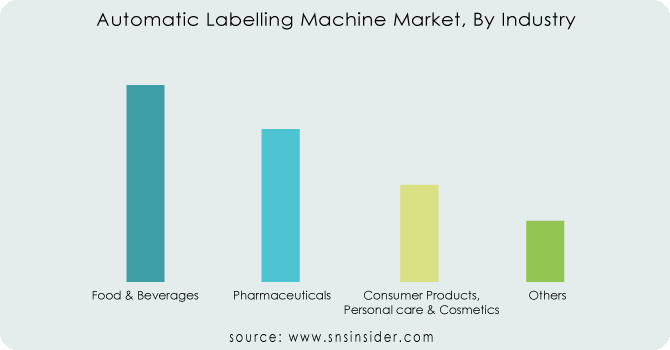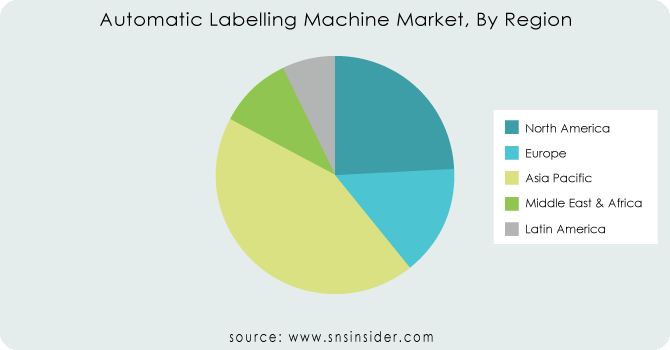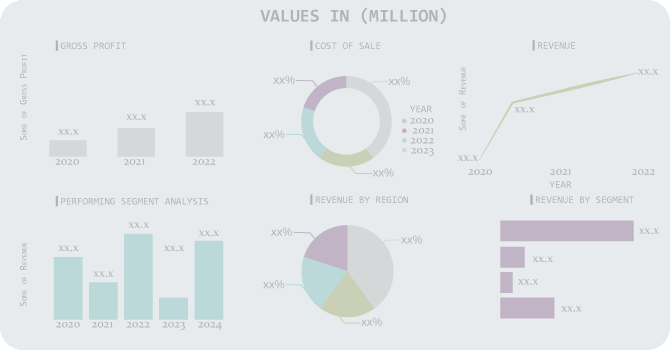The Automatic Labelling Machine Market size was valued at USD 2.8 Billion in 2023 and is now anticipated to grow to USD 3.76 Billion by 2031, displaying a compound annual growth rate (CAGR) of 3.78% during the forecast Period 2024 - 2031.
The automatic labeling machine market is growing at a significant rate with a variety of factors into play. The key driver for the growth is the rising demand towards automation & efficiency as manufacturers are increasing production speeds.

Get More Information on Automatic Labelling Machine Market - Request Sample Report
Automatic labelling is becoming preference compared to manual processes as it ensures consistent and accurate placement of label, minimizing errors and also reduces the labor costs by eliminating manual labeling tasks. Also, the rising focus towards branding & product differentiation is enhancing the appeal of product & increasing the brand recognition. The advancements in labelling technology are helping in smart labeling that allows real-time code verification and track-and-trace functionality like object recognition & defect recognition. Also, the increasing importance of sustainability practices is helping in innovating biodegradable labelling materials & green packaging. Further, the growing consumer preference towards transparency of product information like ingredients, origin, etc. is facilitating for automatic labelling. And the increasing demand for single serving products is creating demand for automatic labelers. All these factors are driving the automatic labelling machine market.
Drivers
High Efficiency requirements with rising production speed is driving the market towards its growth.
Rising emphasis towards product appeal & differentiation with high-quality labels is driving the market.
Restraints
High maintenance cost is creating a restraint in the market growth.
Complexity in integrating with existing product lines is creating a restraint in the market growth.
Opportunities
Expansion in new applications like product marking, coding, and serialization can create growth opportunities.
Implementation of RFID in product labelling is creating growth opportunities for the market.
Rising demand towards high-speed labeling and automation is driving the growth in labeling equipment market. The demand for RFID has features like tracking and anti-counterfeiting that is of great help for manufacturers to track their shipments easily. The labels help in ensuring that products not tampered and are delivered safely. The adoption rate of RFID’s in America is 93% in 2022.
Challenges
Highly unreliable after sales support is creating a challenge in the market growth as companies might become hesitant for the adoption of such technology.
Limited flexibility for short production can create challenges in market growth.
Automatic labeling machines provides high efficiency for large productions but at the same time they may not be cost-efficient for short production quantities. Thus, limiting their preference for diversified product lines or those with seasonal fluctuations in demand is creating challenges for the market growth.
The Russia-Ukraine war has a huge impact on the automatic labeling machine market. The global supply chain disruptions have created problems as Russia being a key supplier for raw materials required for manufacturing of label machines. The war has created shortages of parts which directly raised the prices of components. Also, the energy price hike is complicating things even further as there is 70.72% increase in crude oil prices & coal price increases to 96% in 6 months. Moreover, the war created economic uncertainties with financial burdens making them unable to invest on new equipment’s like labelling machine causing a dip in the market growth. But on the other side, the war has shifted the focus towards domestic production further reducing reliance over global market. The war is pushing into supply chain flexibility which may consecutively increase the adoption of labelling machine. Also, the automatic labelling machine is offering a less labor-intensive solution which might favor in compensation over labor shortages.
Economic slowdown has a huge impact on the automatic labeling machine market. The demand for the machine will take a dip as businesses may face financial burdens and procurement for new machine will be at halt. The slowdown will lower the production levels across manufacturing sector which will further reduce the need for labelling machines because of less requirement of label in products. The reduced production levels have caused shortages of supply of products leading to long lead time affecting availability & pricing of products. But on the other side, the focus towards cost effectiveness & reduced labor cost in long run can drive the market even in this slowdown. Also, the slowdown can raise the demand for refurbished labelling machine creating opportunities for companies that look for affordable options.
By Type
Self-Adhesive/Pressure-Sensitive Labelers
Shrink-Sleeve Labelers
Glue-based Labelers
By Industry
Food & Beverages
Pharmaceuticals
Consumer Products, Personal care & Cosmetics
Others
The Food & Beverage industry is dominating the market with a share of around 46% of the total market. The reason for dominance is because food labeling is an important feature in food and beverage packaging. The label covers the details about the product as well as the producer. Also, label acts as a way it is a way by which the consumers heath is protected in terms of nutrition and food safety.

Need Customized Research on Automatic Labelling Machine Market - Enquiry Now
The Asia-Pacific region is dominating the market with a share of around 43.57% of the total market. The dominance is because of increasing demand over labelling solution among manufacturers. The rising need for packaged food & beverages is driving the growth of the market. The rising standard of living & consumer spending is creating demand for packaged products. Also, high concentration of population is driving the dominance in the region.
North America is the fastest growing region next to Asia-Pacific because of rising demand over packaged foods & Pharmaceuticals.

Regional Outlook
North America
US
Canada
Mexico
Europe
Eastern Europe
Poland
Romania
Hungary
Turkey
Rest of Eastern Europe
Western Europe
Germany
France
UK
Italy
Spain
Netherlands
Switzerland
Austria
Rest of Western Europe
Asia Pacific
China
India
Japan
South Korea
Vietnam
Singapore
Australia
Rest of Asia Pacific
Middle East & Africa
Middle East
UAE
Egypt
Saudi Arabia
Qatar
Rest of the Middle East
Africa
Nigeria
South Africa
Rest of Africa
Latin America
Brazil
Argentina
Colombia
Rest of Latin America
The major key players are The Krones Group, MPI Label Systems, Inc., Salzgitter AG, Fuji Seal International, Inc., ProMach inc., Marchesini Group s.p.a., IMA Group, Accutek Packaging Equipment Companies, Inc., Barry-Wehmiller Group, Inc., Newman Labelling Systems Ltd. and others.
MPI Label Systems, Inc-Company Financial Analysis

| Report Attributes | Details |
|---|---|
| Market Size in 2023 | US$ 2.8 Billion |
| Market Size by 2031 | US$ 3.76 Billion |
| CAGR | CAGR of 3.78% From 2024 to 2031 |
| Base Year | 2023 |
| Forecast Period | 2024-2031 |
| Historical Data | 2020-2022 |
| Report Scope & Coverage | Market Size, Segments Analysis, Competitive Landscape, Regional Analysis, DROC & SWOT Analysis, Forecast Outlook |
| Key Segments | • By Type (Self-Adhesive/Pressure-Sensitive Labelers, Shrink-Sleeve Labelers, Glue-Based Labelers) • By Industry (Food & Beverages, Pharmaceuticals, Consumer Products, Personal care & Cosmetics, Others) |
| Regional Analysis/Coverage | North America (US, Canada, Mexico), Europe (Eastern Europe [Poland, Romania, Hungary, Turkey, Rest of Eastern Europe] Western Europe] Germany, France, UK, Italy, Spain, Netherlands, Switzerland, Austria, Rest of Western Europe]), Asia Pacific (China, India, Japan, South Korea, Vietnam, Singapore, Australia, Rest of Asia Pacific), Middle East & Africa (Middle East [UAE, Egypt, Saudi Arabia, Qatar, Rest of Middle East], Africa [Nigeria, South Africa, Rest of Africa], Latin America (Brazil, Argentina, Colombia, Rest of Latin America) |
| Company Profiles | The Krones Group, MPI Label Systems, Inc., Salzgitter AG, Fuji Seal International, Inc., ProMach inc., Marchesini Group s.p.a., IMA Group, Accutek Packaging Equipment Companies, Inc., Barry-Wehmiller Group, Inc., Newman Labelling Systems Ltd. |
| Key Drivers | • High Efficiency requirements with rising production speed is driving the market towards its growth. • Rising emphasis towards product appeal & differentiation with high-quality labels is driving the market. |
| Restraints | • High maintenance cost is creating a restraint in the market growth. • Complexity in integrating with existing product lines is creating a restraint in the market growth. |
Ans: The Automatic Labelling Machine Market is expected to grow at a CAGR of 3.82% during 2024-2032.
Ans: The Automatic Labelling Machine Market was USD 3.04 Billion in 2023 and is expected to Reach USD 4.25 Billion by 2032.
Ans: The increasing trend of automation in packaging across industries like food & beverages, pharmaceuticals, and cosmetics is driving the demand for automatic labeling machines that improve speed, accuracy, and consistency.
Ans: The “Self-adhesive labelers” segment dominated the Automatic Labelling Machine Market.
Ans: Asia-Pacific dominated the Automatic Labelling Machine Market in 2023.
Table of Contents
1. Introduction
1.1 Market Definition
1.2 Scope
1.3 Research Assumptions
2. Industry Flowchart
3. Research Methodology
4. Market Dynamics
4.1 Drivers
4.2 Restraints
4.3 Opportunities
4.4 Challenges
5. Impact Analysis
5.1 Impact of Russia Ukraine Crisis
5.2 Impact of Economic Slowdown on Major Countries
5.2.1 Introduction
5.2.2 United States
5.2.3 Canada
5.2.4 Germany
5.2.5 France
5.2.6 UK
5.2.7 China
5.2.8 Japan
5.2.9 South Korea
5.2.10 India
6. Value Chain Analysis
7. Porter’s 5 Forces Model
8. Pest Analysis
9. Automatic Labelling Machine Market Segmentation, By Type
9.1 Introduction
9.2 Trend Analysis
9.3 Self-Adhesive/Pressure-Sensitive Labelers
9.4 Shrink-Sleeve Labelers
9.5 Glue-based Labelers
10. Automatic Labelling Machine Market Segmentation, By Industry
10.1 Introduction
10.2 Trend Analysis
10.3 Food & Beverages
10.4 Pharmaceuticals
10.5 Consumer Products, Personal care & Cosmetics
10.6 Others
11. Regional Analysis
11.1 Introduction
11.2 North America
11.2.1 Trend Analysis
11.2.2 North America Automatic Labelling Machine Market, By Country
11.2.3 North America Automatic Labelling Machine Market, By Type
11.2.4 North America Automatic Labelling Machine Market, By Industry
11.2.5 USA
11.2.5.1 USA Automatic Labelling Machine Market, By Type
11.2.5.2 USA Automatic Labelling Machine Market, By Industry
11.2.6 Canada
11.2.6.1 Canada Automatic Labelling Machine Market, By Type
11.2.6.2 Canada Automatic Labelling Machine Market, By Industry
11.2.7 Mexico
11.2.7.1 Mexico Automatic Labelling Machine Market, By Type
11.2.7.2 Mexico Automatic Labelling Machine Market, By Industry
11.3 Europe
11.3.1 Trend Analysis
11.3.2 Eastern Europe
11.3.2.1 Eastern Europe Automatic Labelling Machine Market, By Country
11.3.2.2 Eastern Europe Automatic Labelling Machine Market, By Type
11.3.2.3 Eastern Europe Automatic Labelling Machine Market, By Industry
11.3.2.4 Poland
11.3.2.4.1 Poland Automatic Labelling Machine Market, By Type
11.3.2.4.2 Poland Automatic Labelling Machine Market, By Industry
11.3.2.5 Romania
11.3.2.5.1 Romania Automatic Labelling Machine Market, By Type
11.3.2.5.2 Romania Automatic Labelling Machine Market, By Industry
11.3.2.6 Hungary
11.3.2.6.1 Hungary Automatic Labelling Machine Market, By Type
11.3.2.6.2 Hungary Automatic Labelling Machine Market, By Industry
11.3.2.7 Turkey
11.3.2.7.1 Turkey Automatic Labelling Machine Market, By Type
11.3.2.7.2 Turkey Automatic Labelling Machine Market, By Industry
11.3.2.8 Rest of Eastern Europe
11.3.2.8.1 Rest of Eastern Europe Automatic Labelling Machine Market, By Type
11.3.2.8.2 Rest of Eastern Europe Automatic Labelling Machine Market, By Industry
11.3.3 Western Europe
11.3.3.1 Western Europe Automatic Labelling Machine Market, By Country
11.3.3.2 Western Europe Automatic Labelling Machine Market, By Type
11.3.3.3 Western Europe Automatic Labelling Machine Market, By Industry
11.3.3.4 Germany
11.3.3.4.1 Germany Automatic Labelling Machine Market, By Type
11.3.3.4.2 Germany Automatic Labelling Machine Market, By Industry
11.3.3.5 France
11.3.3.5.1 France Automatic Labelling Machine Market, By Type
11.3.3.5.2 France Automatic Labelling Machine Market, By Industry
11.3.3.6 UK
11.3.3.6.1 UK Automatic Labelling Machine Market, By Type
11.3.3.6.2 UK Automatic Labelling Machine Market, By Industry
11.3.3.7 Italy
11.3.3.7.1 Italy Automatic Labelling Machine Market, By Type
11.3.3.7.2 Italy Automatic Labelling Machine Market, By Industry
11.3.3.8 Spain
11.3.3.8.1 Spain Automatic Labelling Machine Market, By Type
11.3.3.8.2 Spain Automatic Labelling Machine Market, By Industry
11.3.3.9 Netherlands
11.3.3.9.1 Netherlands Automatic Labelling Machine Market, By Type
11.3.3.9.2 Netherlands Automatic Labelling Machine Market, By Industry
11.3.3.10 Switzerland
11.3.3.10.1 Switzerland Automatic Labelling Machine Market, By Type
11.3.3.10.2 Switzerland Automatic Labelling Machine Market, By Industry
11.3.3.11 Austria
11.3.3.11.1 Austria Automatic Labelling Machine Market, By Type
11.3.3.11.2 Austria Automatic Labelling Machine Market, By Industry
11.3.3.12 Rest of Western Europe
11.3.3.12.1 Rest of Western Europe Automatic Labelling Machine Market, By Type
11.3.2.12.2 Rest of Western Europe Automatic Labelling Machine Market, By Industry
11.4 Asia-Pacific
11.4.1 Trend Analysis
11.4.2 Asia Pacific Automatic Labelling Machine Market, By Country
11.4.3 Asia Pacific Automatic Labelling Machine Market, By Type
11.4.4 Asia Pacific Automatic Labelling Machine Market, By Industry
11.4.5 China
11.4.5.1 China Automatic Labelling Machine Market, By Type
11.4.5.2 China Automatic Labelling Machine Market, By Industry
11.4.6 India
11.4.6.1 India Automatic Labelling Machine Market, By Type
11.4.6.2 India Automatic Labelling Machine Market, By Industry
11.4.7 Japan
11.4.7.1 Japan Automatic Labelling Machine Market, By Type
11.4.7.2 Japan Automatic Labelling Machine Market, By Industry
11.4.8 South Korea
11.4.8.1 South Korea Automatic Labelling Machine Market, By Type
11.4.8.2 South Korea Automatic Labelling Machine Market, By Industry
11.4.9 Vietnam
11.4.9.1 Vietnam Automatic Labelling Machine Market, By Type
11.4.9.2 Vietnam Automatic Labelling Machine Market, By Industry
11.4.10 Singapore
11.4.10.1 Singapore Automatic Labelling Machine Market, By Type
11.4.10.2 Singapore Automatic Labelling Machine Market, By Industry
11.4.11 Australia
11.4.11.1 Australia Automatic Labelling Machine Market, By Type
11.4.11.2 Australia Automatic Labelling Machine Market, By Industry
11.4.12 Rest of Asia-Pacific
11.4.12.1 Rest of Asia-Pacific Automatic Labelling Machine Market, By Type
11.4.12.2 Rest of Asia-Pacific Automatic Labelling Machine Market, By Industry
11.5 Middle East & Africa
11.5.1 Trend Analysis
11.5.2 Middle East
11.5.2.1 Middle East Automatic Labelling Machine Market, By Country
11.5.2.2 Middle East Automatic Labelling Machine Market, By Type
11.5.2.3 Middle East Automatic Labelling Machine Market, By Industry
11.5.2.4 UAE
11.5.2.4.1 UAE Automatic Labelling Machine Market, By Type
11.5.2.4.2 UAE Automatic Labelling Machine Market, By Industry
11.5.2.5 Egypt
11.5.2.5.1 Egypt Automatic Labelling Machine Market, By Type
11.5.2.5.2 Egypt Automatic Labelling Machine Market, By Industry
11.5.2.6 Saudi Arabia
11.5.2.6.1 Saudi Arabia Automatic Labelling Machine Market, By Type
11.5.2.6.2 Saudi Arabia Automatic Labelling Machine Market, By Industry
11.5.2.7 Qatar
11.5.2.7.1 Qatar Automatic Labelling Machine Market, By Type
11.5.2.7.2 Qatar Automatic Labelling Machine Market, By Industry
11.5.2.8 Rest of Middle East
11.5.2.8.1 Rest of Middle East Automatic Labelling Machine Market, By Type
11.5.2.8.2 Rest of Middle East Automatic Labelling Machine Market, By Industry
11.5.3 Africa
11.5.3.1 Africa Automatic Labelling Machine Market, By Country
11.5.3.2 Africa Automatic Labelling Machine Market, By Type
11.5.3.3 Africa Automatic Labelling Machine Market, By Industry
11.5.2.4 Nigeria
11.5.2.4.1 South Africa Automatic Labelling Machine Market, By Type
11.5.2.4.2 South Africa Automatic Labelling Machine Market, By Industry
11.5.2.5 South Africa
11.5.2.5.1 South Africa Automatic Labelling Machine Market, By Type
11.5.2.5.2 South Africa Automatic Labelling Machine Market, By Industry
11.5.2.6 Rest of Africa
11.5.2.6.1 Rest of Africa Automatic Labelling Machine Market, By Type
11.5.2.6.2 Rest of Africa Automatic Labelling Machine Market, By Industry
11.6 Latin America
11.6.1 Trend Analysis
11.6.2 Latin America Automatic Labelling Machine Market, By Country
11.6.3 Latin America Automatic Labelling Machine Market, By Type
11.6.4 Latin America Automatic Labelling Machine Market, By Industry
11.6.5 Brazil
11.6.5.1 Brazil Automatic Labelling Machine Market, By Type
11.6.5.2 Brazil Automatic Labelling Machine Market, By Industry
11.6.6 Argentina
11.6.6.1 Argentina Automatic Labelling Machine Market, By Type
11.6.6.2 Argentina Automatic Labelling Machine Market, By Industry
11.6.7 Colombia
11.6.7.1 Colombia Automatic Labelling Machine Market, By Type
11.6.7.2 Colombia Automatic Labelling Machine Market, By Industry
11.6.8 Rest of Latin America
11.6.8.1 Rest of Latin America Automatic Labelling Machine Market, By Type
11.6.8.2 Rest of Latin America Automatic Labelling Machine Market, By Industry
12. Company Profiles
12.1 The Krones Group
12.1.1 Company Overview
12.1.2 Financial
12.1.3 Products/ Services Offered
12.1.4 SWOT Analysis
12.1.5 The SNS View
12.2 MPI Label Systems Inc.
12.2.1 Company Overview
12.2.2 Financial
12.2.3 Products/ Services Offered
12.2.4 SWOT Analysis
12.2.5 The SNS View
12.3 Salzgitter AG
12.3.1 Company Overview
12.3.2 Financial
12.3.3 Products/ Services Offered
12.3.4 SWOT Analysis
12.3.5 The SNS View
12.4 Fuji Seal International Inc.
12.4.1 Company Overview
12.4.2 Financial
12.4.3 Products/ Services Offered
12.4.4 SWOT Analysis
12.4.5 The SNS View
12.5 ProMach Inc.
12.5.1 Company Overview
12.5.2 Financial
12.5.3 Products/ Services Offered
12.5.4 SWOT Analysis
12.5.5 The SNS View
12.6 Marchesini Group s.p.a.
12.6.1 Company Overview
12.6.2 Financial
12.6.3 Products/ Services Offered
12.6.4 SWOT Analysis
12.6.5 The SNS View
12.7 IMA Group
12.7.1 Company Overview
12.7.2 Financial
12.7.3 Products/ Services Offered
12.7.4 SWOT Analysis
12.7.5 The SNS View
12.8 Accutek Packaging Equipment Companies Inc.
12.8.1 Company Overview
12.8.2 Financial
12.8.3 Products/ Services Offered
12.8.4 SWOT Analysis
12.8.5 The SNS View
12.9 Barry-Wehmiller Group Inc.
12.9.1 Company Overview
12.9.2 Financial
12.9.3 Products/ Services Offered
12.9.4 SWOT Analysis
12.9.5 The SNS View
12.10 Newman Labelling Systems Ltd.
12.10.1 Company Overview
12.10.2 Financial
12.10.3 Products/ Services Offered
12.10.4 SWOT Analysis
12.10.5 The SNS View
13. Competitive Landscape
13.1 Competitive Benchmarking
13.2 Market Share Analysis
13.3 Recent Developments
13.3.1 Industry News
13.3.2 Company News
13.3.3 Mergers & Acquisitions
14. Use Cases and Best Practices
15. Conclusion
An accurate research report requires proper strategizing as well as implementation. There are multiple factors involved in the completion of good and accurate research report and selecting the best methodology to compete the research is the toughest part. Since the research reports we provide play a crucial role in any company’s decision-making process, therefore we at SNS Insider always believe that we should choose the best method which gives us results closer to reality. This allows us to reach at a stage wherein we can provide our clients best and accurate investment to output ratio.
Each report that we prepare takes a timeframe of 350-400 business hours for production. Starting from the selection of titles through a couple of in-depth brain storming session to the final QC process before uploading our titles on our website we dedicate around 350 working hours. The titles are selected based on their current market cap and the foreseen CAGR and growth.
The 5 steps process:
Step 1: Secondary Research:
Secondary Research or Desk Research is as the name suggests is a research process wherein, we collect data through the readily available information. In this process we use various paid and unpaid databases which our team has access to and gather data through the same. This includes examining of listed companies’ annual reports, Journals, SEC filling etc. Apart from this our team has access to various associations across the globe across different industries. Lastly, we have exchange relationships with various university as well as individual libraries.

Step 2: Primary Research
When we talk about primary research, it is a type of study in which the researchers collect relevant data samples directly, rather than relying on previously collected data. This type of research is focused on gaining content specific facts that can be sued to solve specific problems. Since the collected data is fresh and first hand therefore it makes the study more accurate and genuine.
We at SNS Insider have divided Primary Research into 2 parts.
Part 1 wherein we interview the KOLs of major players as well as the upcoming ones across various geographic regions. This allows us to have their view over the market scenario and acts as an important tool to come closer to the accurate market numbers. As many as 45 paid and unpaid primary interviews are taken from both the demand and supply side of the industry to make sure we land at an accurate judgement and analysis of the market.
This step involves the triangulation of data wherein our team analyses the interview transcripts, online survey responses and observation of on filed participants. The below mentioned chart should give a better understanding of the part 1 of the primary interview.

Part 2: In this part of primary research the data collected via secondary research and the part 1 of the primary research is validated with the interviews from individual consultants and subject matter experts.
Consultants are those set of people who have at least 12 years of experience and expertise within the industry whereas Subject Matter Experts are those with at least 15 years of experience behind their back within the same space. The data with the help of two main processes i.e., FGDs (Focused Group Discussions) and IDs (Individual Discussions). This gives us a 3rd party nonbiased primary view of the market scenario making it a more dependable one while collation of the data pointers.
Step 3: Data Bank Validation
Once all the information is collected via primary and secondary sources, we run that information for data validation. At our intelligence centre our research heads track a lot of information related to the market which includes the quarterly reports, the daily stock prices, and other relevant information. Our data bank server gets updated every fortnight and that is how the information which we collected using our primary and secondary information is revalidated in real time.

Step 4: QA/QC Process
After all the data collection and validation our team does a final level of quality check and quality assurance to get rid of any unwanted or undesired mistakes. This might include but not limited to getting rid of the any typos, duplication of numbers or missing of any important information. The people involved in this process include technical content writers, research heads and graphics people. Once this process is completed the title gets uploader on our platform for our clients to read it.
Step 5: Final QC/QA Process:
This is the last process and comes when the client has ordered the study. In this process a final QA/QC is done before the study is emailed to the client. Since we believe in giving our clients a good experience of our research studies, therefore, to make sure that we do not lack at our end in any way humanly possible we do a final round of quality check and then dispatch the study to the client.
The Industrial Control & Factory Automation Market Size was valued at USD 226.93 Billion in 2023 and is now anticipated to grow to USD 513.82 Billion by 2032, displaying a compound annual growth rate (CAGR) of 9.51% during the forecast Period 2024-2032.
The Vibration Control System Market Size was esteemed at USD 5.21 billion in 2023 and is supposed to arrive at USD 8.87 billion by 2032 and develop at a CAGR of 6.1% over the forecast period 2024-2032.
The HVAC Control System Market Size was valued at USD 18.98 Billion in 2023 and is expected to reach USD 44.09 Billion by 2032 and grow at a CAGR of 9.82% over the forecast period 2024-2032.
The Carbide Tools Market size was estimated at USD 9.32 billion in 2023 and is expected to reach USD 16.25 billion by 2032 at a CAGR of 6.14% during the forecast period of 2024-2032.
The Functional Safety Market size was valued at USD 8.31Billion in 2023 and is now anticipated to grow USD 14.24 Billion by 2032, displaying a compound annual growth rate (CAGR) of 6.17% during the forecast Period 2024-2032.
The Computer Numerical Control Machines (CNC) Market size was estimated at USD 66.4 Billion in 2023 and is expected to reach USD 162.16 Billion by 2032 at a CAGR of 10.43% during the forecast period of 2024-2032.
Hi! Click one of our member below to chat on Phone